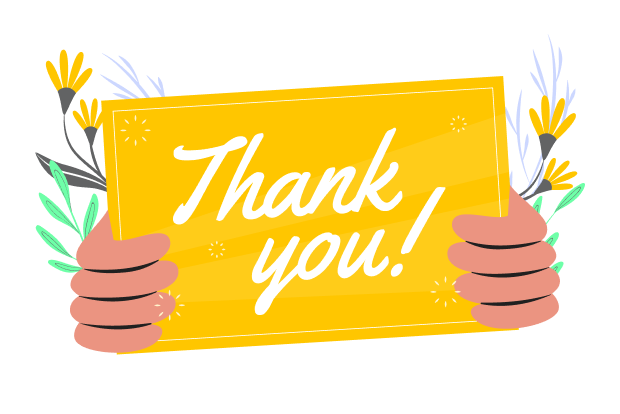How to Build a Digital Twin App: Features, Process & Cost

By Darshak Doshi
November 26, 2025
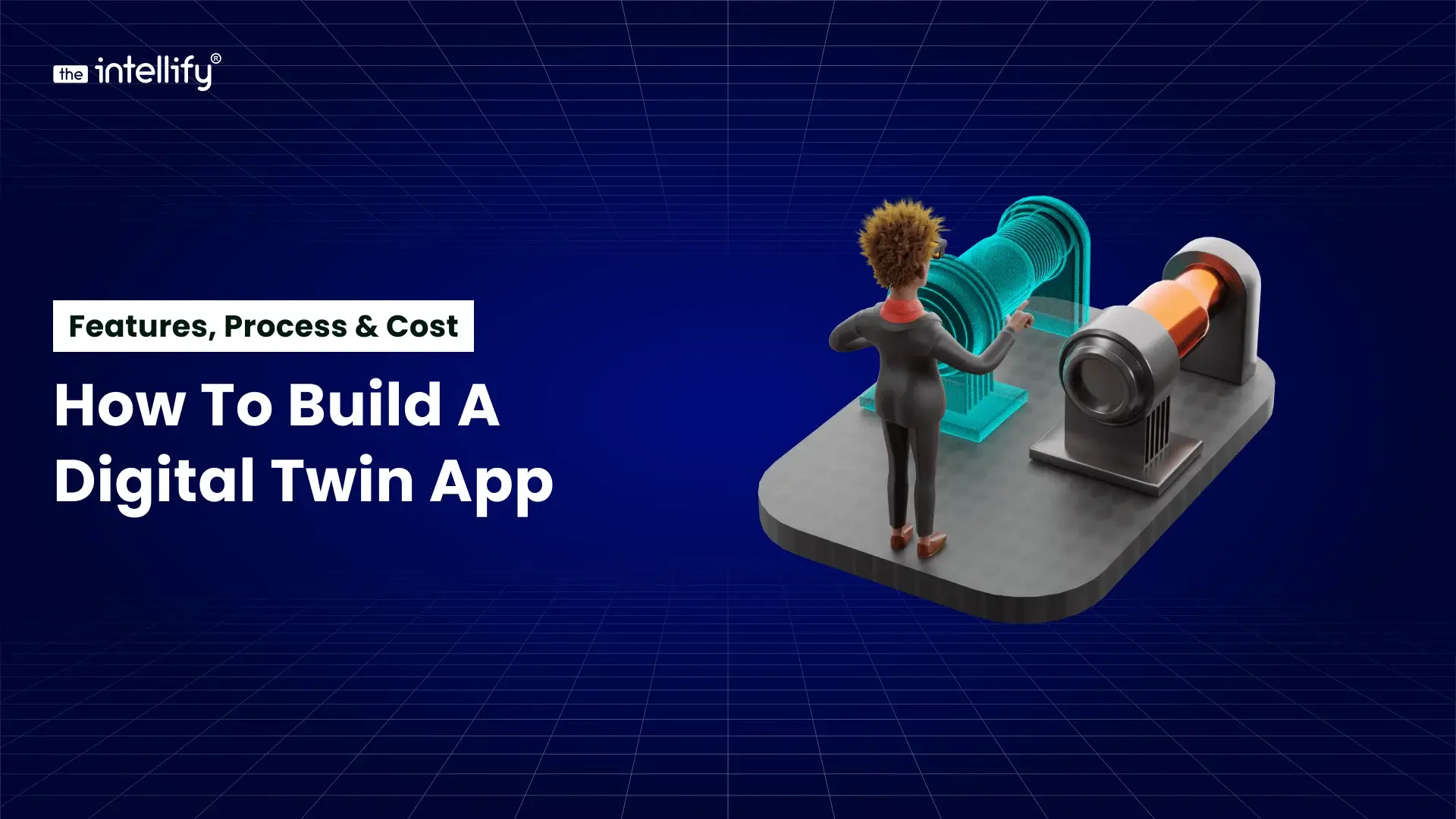
Summary:
A digital twin app creates a real-time virtual model of a physical asset, which helps businesses monitor performance, predict failures, and make smarter decisions. This blog explains what digital twin apps are, how they work, their key features, and the step-by-step development process. It also covers cost, timelines, challenges, and real industry use cases. If you’re planning to build a digital twin solution, this guide walks you through everything you need to know.
If you’ve been anywhere near the tech world lately, you’ve probably heard the term digital twin app floating around like it’s the new celebrity in town. And honestly? It kind of is. These apps let you build a virtual copy of a physical object or system, like giving your machine a digital doppelgänger, minus the awkward family dinners.
And if you’ve been wondering, “Okay, but how does someone even build one of these things?” you’re in the right place. I’ll walk you through what a digital twin app actually is, how it works, what features matter, the full development process, and yes… the part everyone whispers about: the cost.
Let’s dig in.
What is a digital twin app?
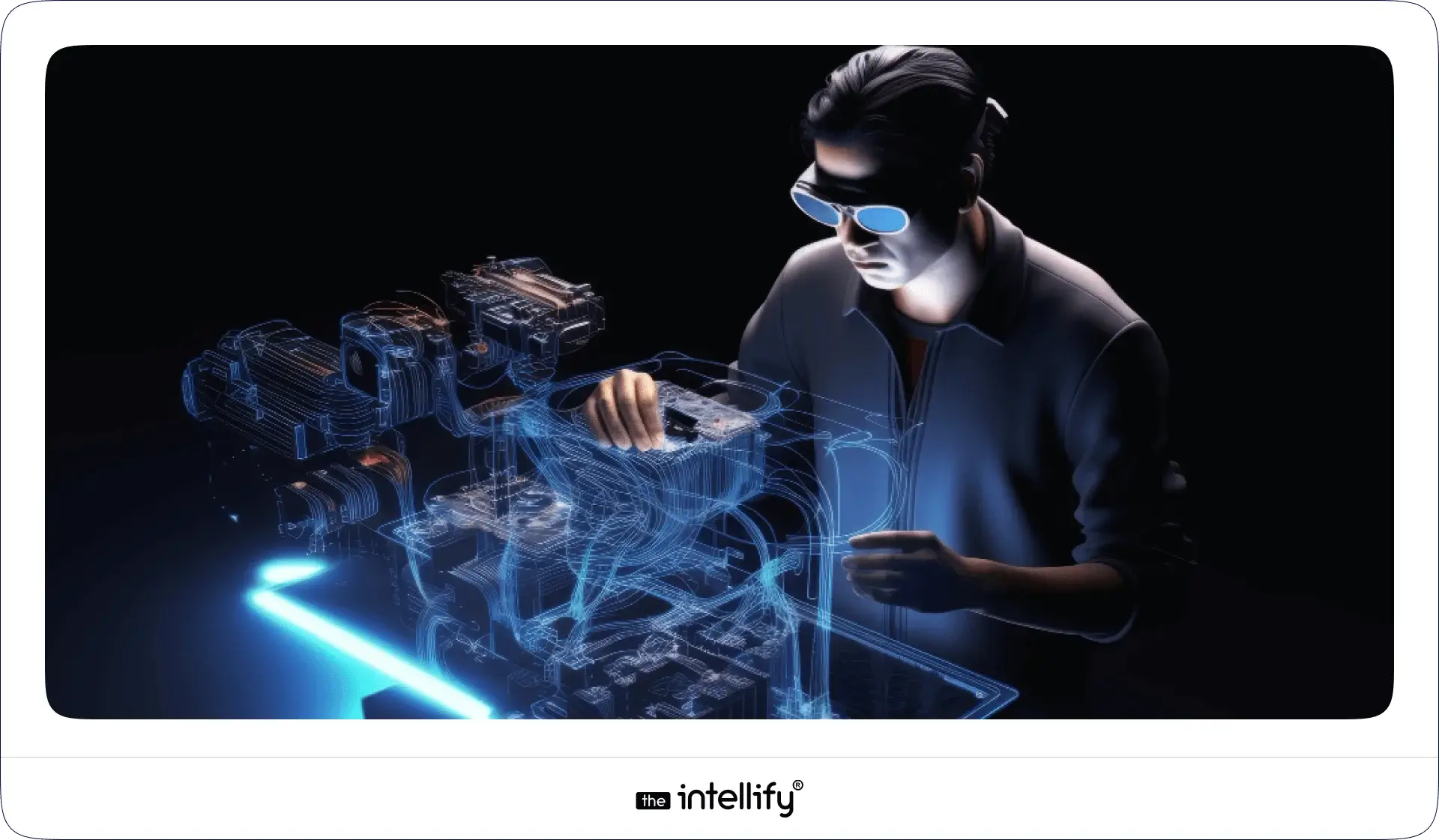
A digital twin app is basically a supercharged software tool that creates a virtual version of a physical object or system. This little “twin” behaves almost like the real thing because it’s constantly fed real data from sensors, IoT devices, and other data channels.
Think of it like tracking your car’s mileage, speed, and temperature, except your car’s digital twin can predict problems before you even hear that weird rattling noise you always ignore.
Digital twin vs simulation vs IoT dashboard
A quick “don’t mix these up” moment:
- Digital Twin: A living, breathing (well, not literally) model that updates continuously with real-world data.
- Simulation: More like a snapshot in time. Useful, but it doesn’t live beyond the moment.
- IoT Dashboard: Shows you data from IoT devices, but doesn’t recreate the entire system.
Different tools, different vibes.
Core Components
- Physical object: The thing you’re trying to model, factory machine, building, car… or your office coffee machine (which honestly needs monitoring).
- Virtual replica: The digital look-alike sitting inside your app.
- Data connection: The artery that keeps everything alive and synced.
Types of Digital Twins
- Components: Zooms in on individual parts.
- Asset: Represents complete equipment/machines or assets.
- System: Models interconnected components.
- Process: Covers workflows and operations.
- Enterprise: Encompasses the entire organization, ambitious yet powerful.
Why Digital Twin Apps Matter in 2026 (Top Benefits)
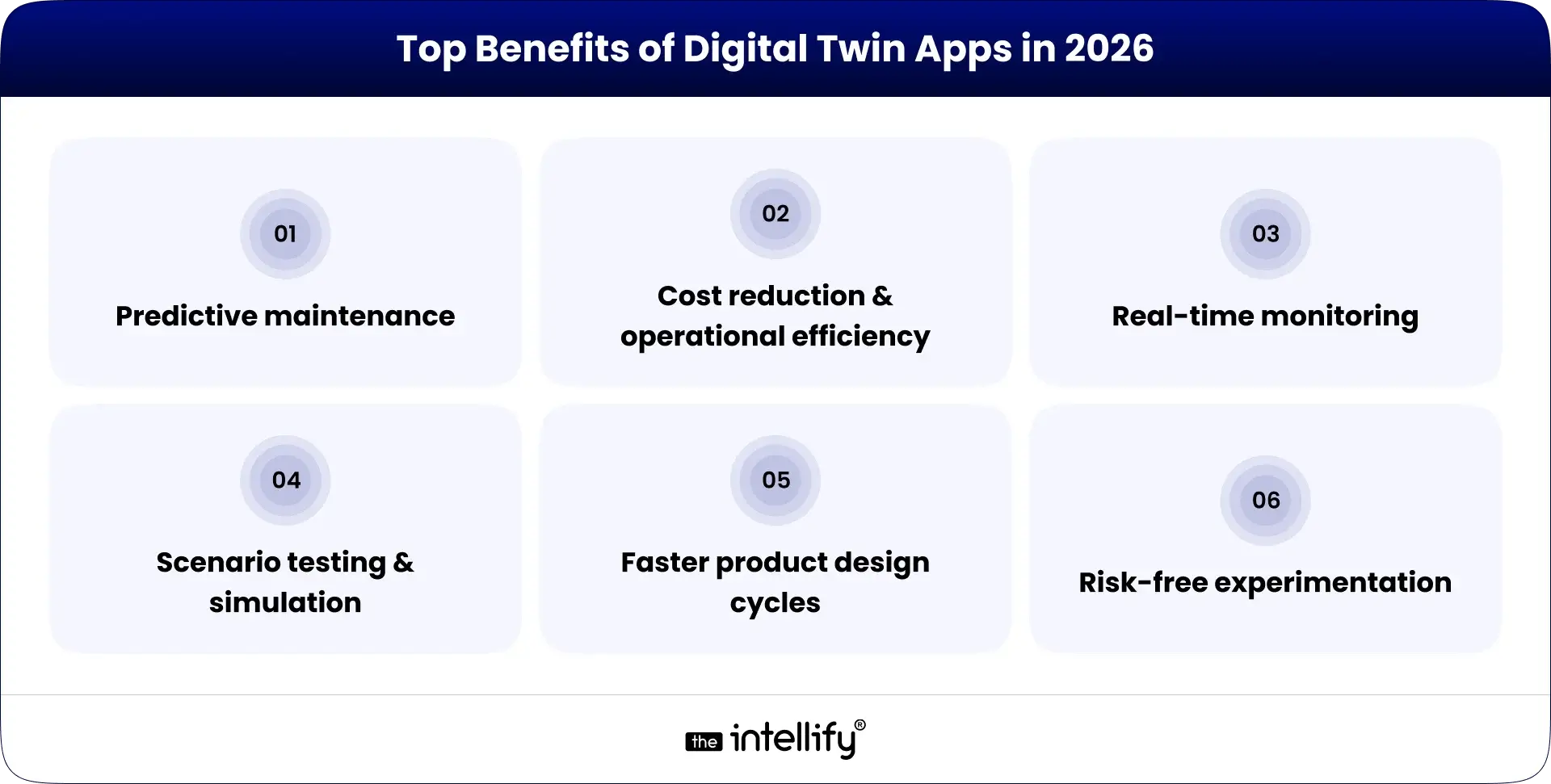
Digital twins are not just “cool tech.” They genuinely help businesses work smarter.
- Predictive maintenance: Spot problems before they happen. No surprises. No breakdown drama.
- Cost reduction & operational efficiency: Small tweaks + data insights = big savings. Your finance team will smile.
- Real-time monitoring: Organizations can continuously track their systems. See what’s happening and if something’s off… fix it fast.
- Scenario testing & simulation: Try ideas without risking anything. It’s like testing a haircut with an AR app before committing.
- Faster product design cycles: No more back-and-forth physical prototypes. Test virtually.
- Risk-free experimentation: Break things in the digital world, your physical assets stay safe and judgment-free.
How Does a Digital Twin App Work? (Step-by-Step Workflow)
Here’s the behind-the-scenes of how these apps actually do their magic:
1. Data collection from sensors/IoT devices
Sensors on the physical object collect data such as temperature, pressure, speed, basically whatever the object considers “personal updates.”
2. Real-time data processing & analytics
After collecting the data, it’s processed and interpreted in real-time through specialized analytics engines.
3. 3D visualization of the physical object
This is where things get fancy. The data transforms into a 3D visual that you can rotate, zoom, and explore at your leisure.
4. Predictive analytics & automation
The app starts predicting possible issues. Almost like when you know your laptop fan is about to sound like a helicopter again.
5. Continuous feedback loop
Insights gathered from the digital twin are used to optimize both the virtual model and the real-world object.
Key Features of a Digital Twin App

- 3D modeling & visualization: Delivers an immersive experience of the digital twin.
- Real-time Data Sync: Ensures the virtual model remains updated with every change in the physical counterpart.
- IoT/Edge Device Integration: Seamlessly connects various IoT devices for efficient data collection.
- Predictive Analytics (AI/ML): Employs sophisticated algorithms to forecast future trends.
- Asset Performance Monitoring: Tracks performance metrics to ensure everything operates smoothly.
- Simulation & Scenario Testing: Enables experimentation within a no-risk environment.
- Alerts, Insights & Reporting Dashboards: Keeps users informed and provides actionable insights.
- Cloud Storage & Data Management: Offers scalable solutions for handling large volumes of data.
- Digital Thread Integration: Links information across different systems and processes.
- Role-Based Access Control (RBAC): Guarantees that only authorized personnel can access sensitive information.
How to Build a Digital Twin App: Step-by-Step Process
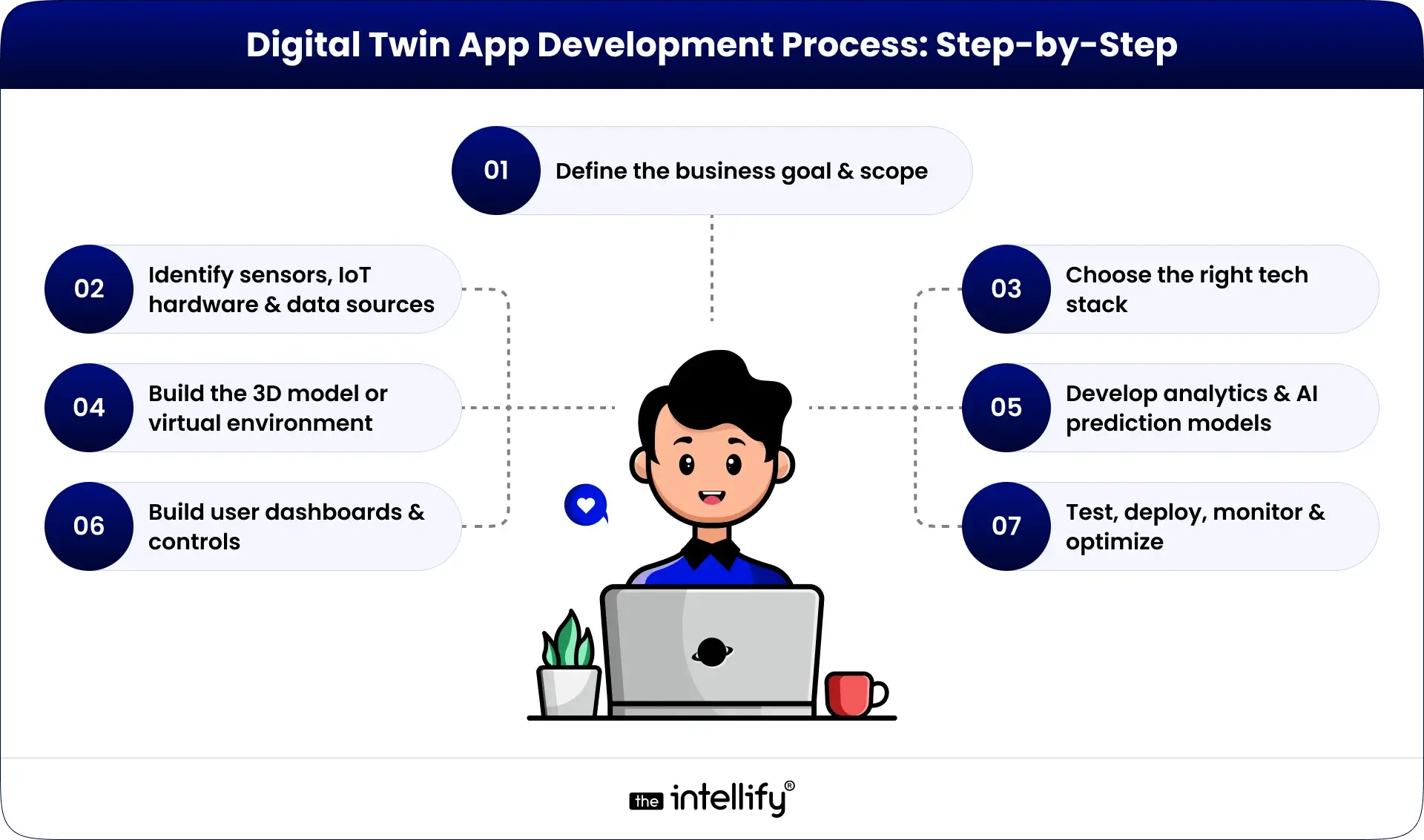
Step 1: Define the business goal & scope
Start by pinpointing what you hope to achieve, whether it’s enhancing efficiency, cutting costs, or implementing predictive maintenance.
Step 2: Identify sensors, IoT hardware & data sources
Select the right technology components that will feed critical data into your application.
Step 3: Choose the right tech stack
Opt for a tech stack that aligns with your needs, covering Frontend, Backend, IoT, and AI components.
Step 4: Build the 3D model or virtual environment
Craft a realistic digital representation of the physical object or system.
Step 5: Establish real-time data integration
Ensure that the digital twin receives consistent updates from its physical counterpart.
Step 6: Develop analytics & AI prediction models
Integrate predictive models tailored to meet your business objectives.
Step 7: Build user dashboards & controls
Design user-friendly interfaces that allow easy interaction with the app.
Step 8: Test, deploy, monitor & optimize
Conduct thorough testing, deploy the app, and refine it based on performance feedback.
Digital Twin App Architecture (Explained Simply)
- IoT Device Layer: This layer includes all the hardware that captures data.
- Connectivity Layer: Facilitates data transfer through technologies like MQTT, 5G, and edge computing.
- Cloud/Server Layer: The hub where data and models are stored and processed.
- Data Analytics & AI Layer: Responsible for interpreting data and generating insights.
- Application/UI Layer: The user interface that grants access to features and insights.
- Security Layer: Protects data and ensures compliance.
Use Cases of Digital Twin Apps Across Industries
- Manufacturing: Optimize production lines like a pro to boost efficiency.
- Healthcare & Medical Devices: Monitor patients’ health or devices to enhance treatment outcomes.
- Automotive & EVs: Improve vehicle design, performance, and manufacturing processes.
- Smart Buildings / Real Estate: Manage and optimize building operations and energy usage
- Energy & Utilities: Handle grids management and energy flow without chaos.
- Logistics & Supply Chain: Real-time tracking to streamline supply chain processes
- Retail & Warehousing: Optimize inventory management and planning = less stress.
- Aerospace & Defense: Test and validate new systems without any risk
Cost to Build a Digital Twin App in 2026
Cost Factors
- Software Complexity: More intricate apps will necessitate larger budgets.
- Integration Needs: Incorporating multiple systems can drive up costs.
- Data Volume: Higher data volumes can influence expenses.
Average Development Cost Breakdown
On average, you can expect to invest anywhere between $50,000 to $500,000, depending on scale and features. Yep, wide range, but that’s the truth.
How Long Does It Take to Build a Digital Twin App?
The timeline for developing a digital twin app can vary, but generally falls between 3 months to over a year, depending on the complexity involved.
Challenges in Digital Twin App Development
- Data Quality and Management: Ensuring data accuracy can be a hurdle.
- Integration Issues: Merging various systems may come with complexities.
- Cost Constraints: Balancing desired features with budget limitations can be tricky.
The Future of Digital Twin Apps (2026-2030)
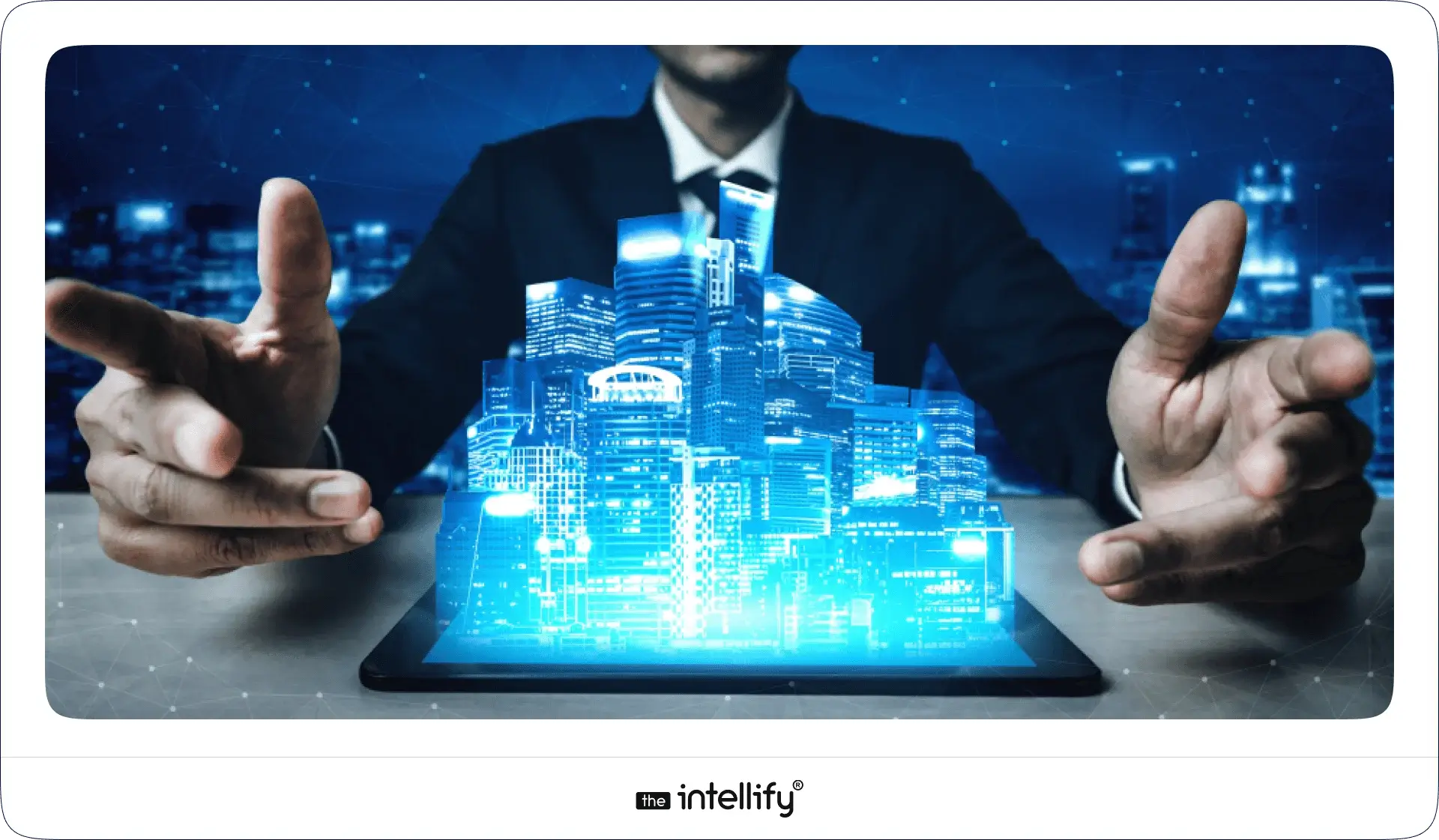
- AI-powered Autonomous Twins: Creating smarter, self-managing systems.
- Digital twins + metaverse: Blending virtual experiences with digital twins.
- Multi-agent simulations: Enhancements in collaborative simulations.
- Industry 5.0 & robotics integration: Merging advanced technologies to optimize operations.
Basically, the future is wild and exciting.
Why Hire a Digital Twin App Development Company?
Partnering with a specialized company comes with numerous advantages:
- Faster Development: Teams experienced in crafting digital twins can speed up the process.
- Expert 3D Modeling: Skilled professionals help create realistic and operational models.
- IoT & AI Integration: They bring in-depth knowledge of cutting-edge technologies.
- Enterprise Security: Ensures that the app is constructed with top-tier security measures.
At The Intellify, we offer tailored digital twin solutions designed to meet your unique business requirements. Our expertise in AI and IoT integration can elevate your app development efforts.
Conclusion
Building a digital twin app is basically your ticket to smarter, future-ready operations. Whether you want predictive maintenance, better monitoring, faster product cycles, or just fewer surprises, a digital twin helps.
Follow the process, get the right tools, and bring in experts when needed. Feel free to connect with The Intellify for expert help in developing your digital twin app!
Frequently Asked Questions (FAQs)
1. What is a digital twin app and how does it work?
It’s a virtual copy of a real-world object or system that uses real-time data to show what’s happening, predict issues, and help you make better decisions.
2. How do you build a digital twin application step-by-step?
Define goals, set up sensors, pick a tech stack, build 3D models, integrate real-time data, create AI models, design dashboards, and test everything.
3. What technologies and platforms are used to develop a digital twin app?
Typical technologies include IoT platforms like AWS IoT, data analytics tools like TensorFlow, and frontend frameworks like React or Angular.
4. How much does it cost to develop a digital twin app in 2026?
Anywhere between $50,000 to $500,000, depending on complexity.
5. How do IoT devices and sensors integrate with digital twin systems?
Sensors capture live data → data flows to the twin → the app analyzes and updates the model.
6. What are the must-have features of a digital twin application?
Essential features include 3D modeling, real-time data synchronization, predictive analytics, scenario testing, and easy-to-use dashboards.
7. Which industries use digital twin apps the most and why?
Manufacturing, healthcare, and logistics leverage digital twin apps to enhance operational efficiency and refine product lifecycle management.
8. What is the difference between a digital twin and a simulation?
A digital twin continuously updates and interacts with real-world data, whereas a simulation represents a static model used for discrete scenarios.

Written By, Darshak Doshi
With over a decade of experience, Darshak is a technopreneur specializing in cloud-based applications and product development in healthcare, insurance, and manufacturing. He excels in AWS Cloud, backend development, and immersive technologies like AR/VR to drive innovation and efficiency. Darshak has also explored AI/ML in insurance and healthcare, pushing the boundaries of technology to solve complex problems. His user-focused, results-driven approach ensures he builds scalable cloud solutions, cutting-edge AR/VR experiences, and AI-driven insights that meet today’s demands while anticipating future needs.


How to Build an AI-Powered Marketplace App: Development Guide
Summary: Building an AI-powered marketplace app isn’t just about coding it’s about crafting a smarter buying and selling experience. This guide breaks down everything from research and design to choosing the right tech stack, integrating AI tools, and launching successfully. Learn how personalization, chatbots, and analytics can set your marketplace apart and future-proof your business […]
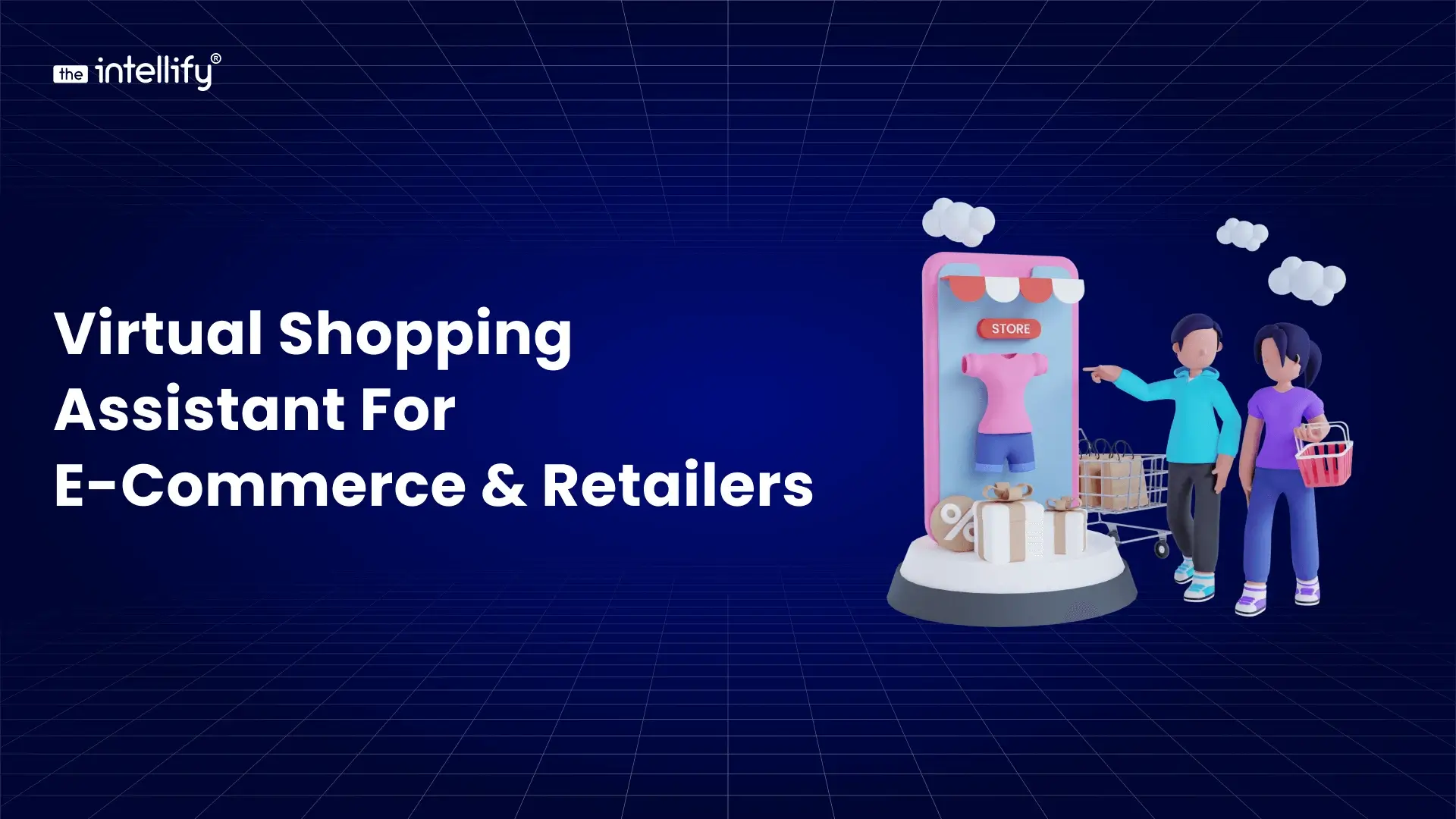

Virtual Shopping Assistant for E-commerce & Retailers
Summary: Ever wished your online store could greet shoppers like a real person would? That’s the magic of virtual shopping assistants. They chat, recommend, and even remember what customers like, turning casual visitors into confident buyers. In this blog, we’ll unpack how these AI helpers are changing e-commerce and why partnering with The Intellify might […]
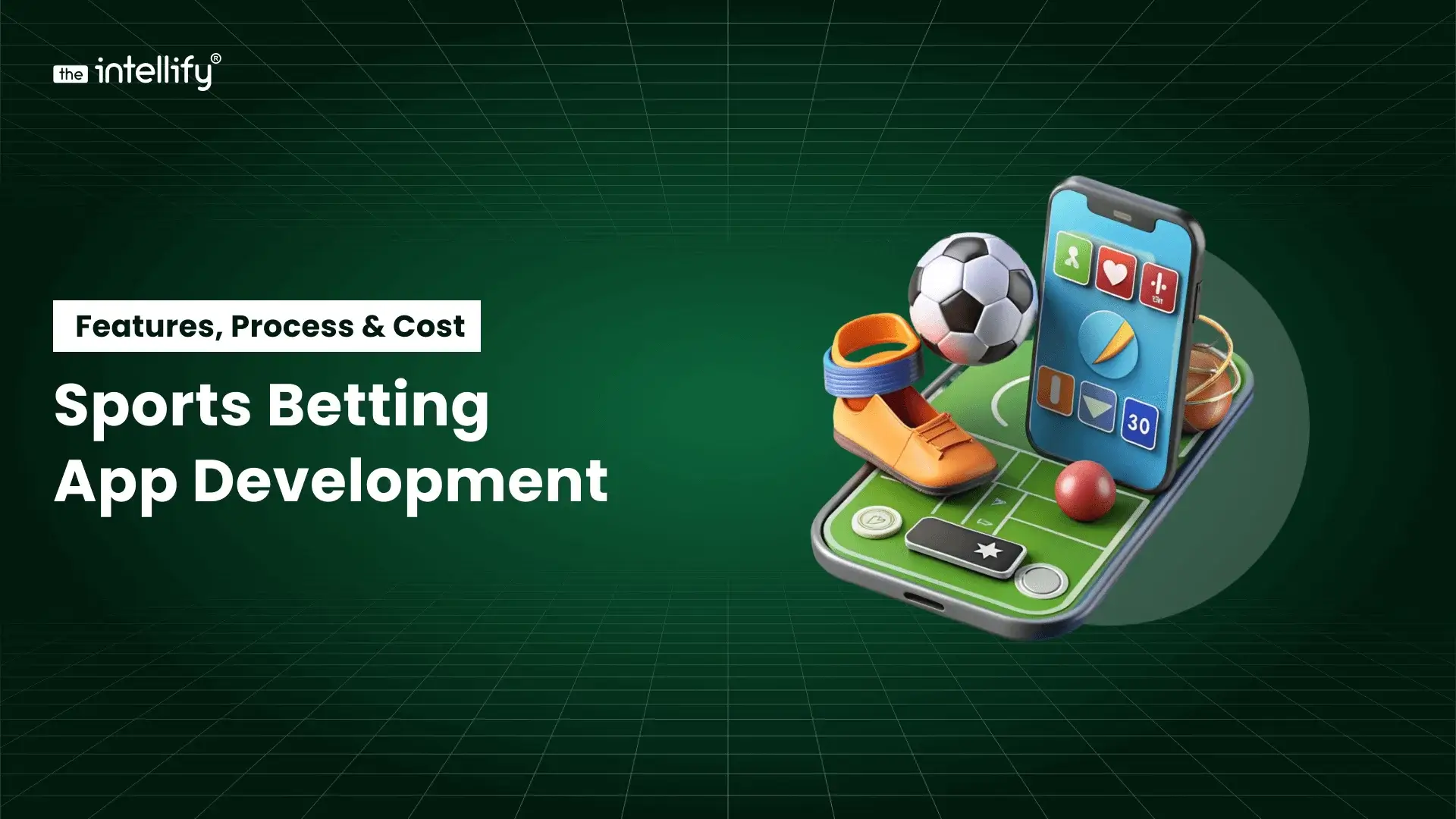

Sports Betting App Development: Features, Process & Cost
Summary: This blog offers a complete guide to sports betting app development, explaining how to create a secure, feature-rich, and user-friendly betting platform. It discusses essential features like live betting, multiple payment options, and responsible gambling tools, along with the full development process, cost factors, and future trends such as AI, AR/VR, and blockchain integration. […]


Grocery Delivery App Development: Cost, Features, & Tech Guide
Summary: In this blog, we explore how to build an on-demand grocery delivery app development in 2026, from key features and tech stack to cost estimates, business models, and scaling strategies. Whether you’re a startup or established retailer, you’ll get a clear roadmap to launch and grow a grocery-delivery platform that wins in today’s competitive […]
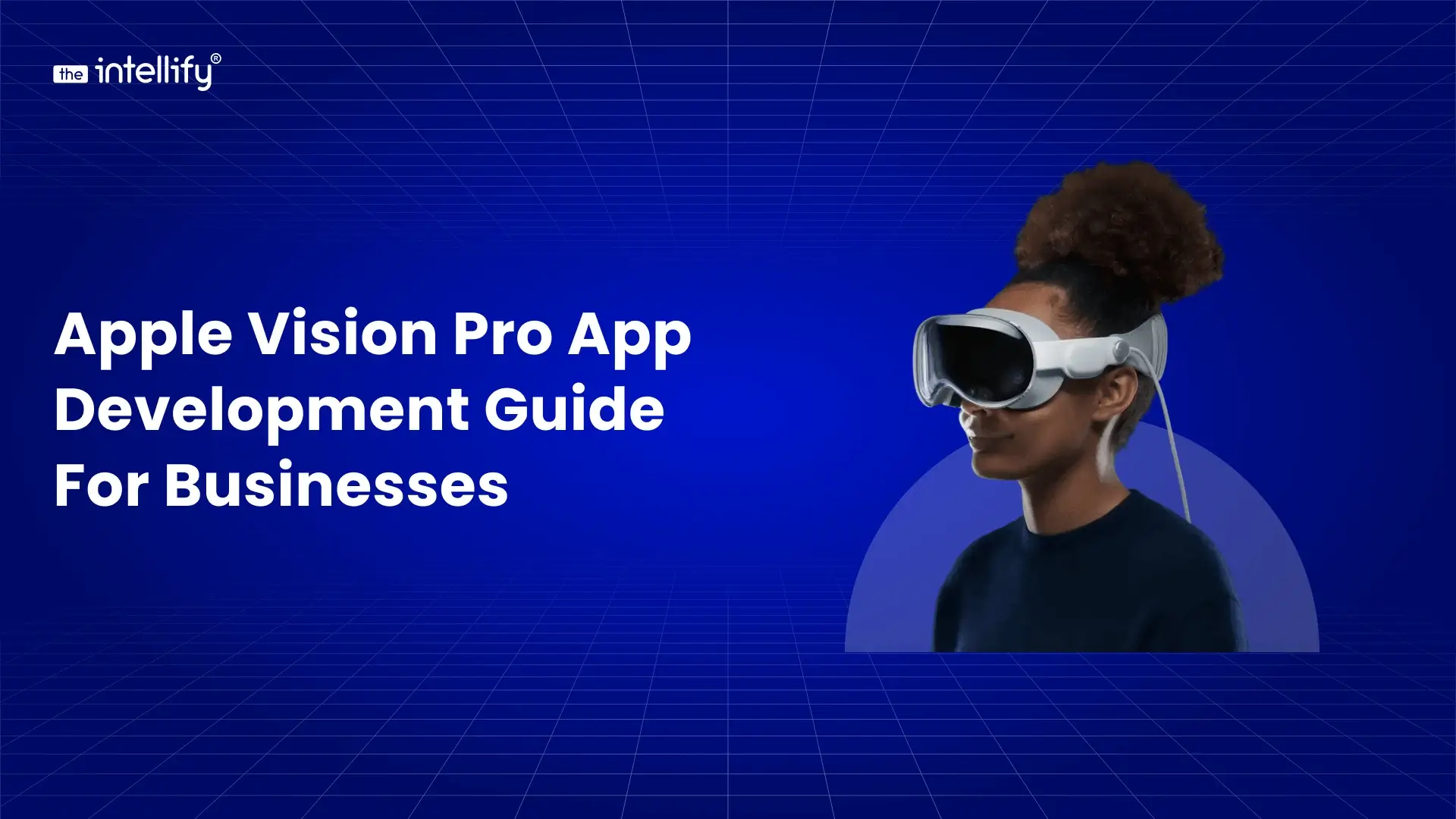

Apple Vision Pro App Development Guide for Businesses
Summary: This blog breaks down Apple Vision Pro app development in a simple, practical way for businesses exploring AR and VR app solutions. It explains what the device can do, where it fits across industries like healthcare, retail, education, and real estate, and how the full development process works from concept to launch. You’ll also […]


How to Build an AI-Powered Marketplace App: Development Guide
Summary: Building an AI-powered marketplace app isn’t just about coding it’s about crafting a smarter buying and selling experience. This guide breaks down everything from research and design to choosing the right tech stack, integrating AI tools, and launching successfully. Learn how personalization, chatbots, and analytics can set your marketplace apart and future-proof your business […]
0
+0
+0
+0
+Committed Delivery Leads To Client Satisfaction
Client Testimonials that keep our expert's spirits highly motivated to deliver extraordinary solutions.



















